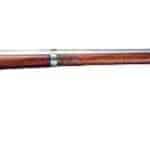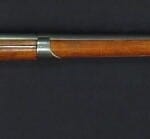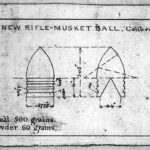
The Springfield Trapdoor is one of the most enduring symbols of American firearm history, a true testament to the rapid technological developments of the late 19th century. This iconic weapon helped to define an era of military history and played a pivotal role in the evolution of the American West.
The Genesis of the Trapdoor: Predecessors and Innovations
The development of the Springfield Trapdoor is rooted in the urgent needs of the U.S. Army following the Civil War. The primary service weapon of that conflict, the Springfield Model 1861, was a muzzle-loading rifled musket. Although reliable and accurate for its time, it was also slow to load and fire. With advancements in breech-loading and metallic cartridge technology, the U.S. Army sought a more effective firearm solution.
Enter Erskine S. Allin, a master armorer at the Springfield Armory. Allin devised an ingenious conversion mechanism for existing muzzle-loading rifles. His design included a hinged breechblock that flipped up and forward, similar to a trapdoor, allowing soldiers to load cartridges directly into the breech. The "Allin Conversion," patented in 1865, facilitated the transition from muzzle-loaders to breech-loaders, and this formed the basis of the Springfield Trapdoor.

The Making of a Legend: Manufacturing the Springfield Trapdoor
The Springfield Armory in Springfield, Massachusetts was the main production site for the Trapdoor rifles. The first iteration was the Model 1865, also known as the First Allin, chambered for .58 caliber rimfire ammunition. Approximately 5,000 units were produced from 1865 to 1866. It was quickly followed by the Model 1866 or Second Allin, designed for the new .50-70 centerfire cartridge. This model saw improvements in breechblock design and had a production run of around 25,000 units.
The subsequent models, the Model 1868 and Model 1870, were entirely new builds and not conversions. The Model 1868, using the same .50-70 cartridge, had about 52,000 units produced. The Model 1870 was a significant departure as it was chambered for a .50-70 cartridge designed for use in metallic cartridge conversions of the M1863 musket, with approximately 11,000 units made.
Springfield Armory wasn't the only manufacturer of the Trapdoor. Some commercial models were produced by companies such as Harrington & Richardson and Officer's Model rifles by the C. Sharps Arms Co.
The Apex of the Trapdoor: The Model 1873 and Its Variations
The Springfield Model 1873 marks the high point of the Trapdoor's development. This was the first model chambered for the new .45-70 Government cartridge, providing better range and accuracy than the previous .50-70 cartridge. It was this model that truly earned the name "Trapdoor," and it would be the mainstay of the U.S. Army until the advent of the Krag-Jorgensen bolt-action rifle in 1892.
Three variations of the Model 1873 were produced: the infantry rifle, the cavalry carbine, and the artillery model. Approximately 700,000 units of the Model 1873 were manufactured by the Springfield Armory between 1873 and 1889.
The infantry rifle, measuring nearly 52 inches with a 32.5-inch barrel, was intended for use by foot soldiers. The cavalry carbine, a shorter 41-inch version with a 22-inch barrel, was designed for mounted troops, while the artillery model was issued to artillery crews for close defense.
Performance and Reception: Praise, Criticisms, and Consequences
The .45-70 cartridge used in the Model 1873 was highly effective, with a muzzle velocity of about 1,300 feet per second and a maximum effective range of about 1,000 yards. The .50-70 cartridge used in earlier models had slightly less range and power.
Despite these advantages, the Springfield Trapdoor did have some significant drawbacks. Its single-shot design was slower than the repeating rifles coming onto the market, such as the Winchester lever-action. However, the U.S. Army preferred the Trapdoor for its simplicity and lower ammunition usage.
The Trapdoor also faced criticism following the Battle of Little Bighorn in 1876, where General George Custer's 7th Cavalry was defeated by Lakota, Cheyenne, and Arapaho warriors. Some survivors reported that the Trapdoor rifles jammed during the fight due to a design flaw in the extractor. However, these claims remain controversial, as many argue that the defeat was due to tactical errors rather than equipment failure.
The Trapdoor in Context: Competing Battle Rifles
During the Springfield Trapdoor's service, the U.S. Army was not alone in its adoption of single-shot, breech-loading rifles. The British used the Martini-Henry, while the Germans fielded the Mauser Model 1871. Both were similarly chambered for large-caliber black powder cartridges.
The key rivals for the Springfield Trapdoor within the U.S. were the Sharps Rifle and the Remington Rolling Block, both single-shot rifles that were favored by sharpshooters for their accuracy and power. However, neither of these models were adopted by the U.S. Army as the standard issue rifle.
Legacy and Continued Use
Even after it was replaced as the standard service rifle, the Trapdoor continued to see use in the Spanish-American War and the Philippine-American War. The weapon also found favor among civilians in the American West, where it was popular for hunting and personal defense.
Several famous figures are known to have used the Springfield Trapdoor. Buffalo Bill Cody used a customized version in his Wild West Show, while Apache leader Geronimo was photographed with a captured Model 1873 carbine.
In conclusion, the Springfield Trapdoor, while not without its flaws, stands as a key piece of American military history. It represents the transformative period following the Civil War when innovation and necessity combined to drive rapid advancements in firearms technology. Its legacy is carried on in the collections of enthusiasts and in the annals of history, where it has carved out an undeniable place of importance.
Discussions on the Trapdoor:
Read more about the Springfield Trapdoor here:


If you know of any forums or sites that should be referenced on this listing, please let us know here.



